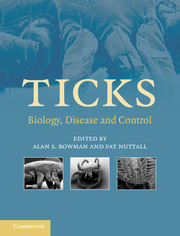Book contents
- Frontmatter
- Contents
- List of contributors
- Preface
- 1 Systematics and evolution of ticks with a list of valid genus and species names
- 2 The impact of tick ecology on pathogen transmission dynamics
- 3 Tick salivary glands: the physiology of tick water balance and their role in pathogen trafficking and transmission
- 4 Tick saliva: from pharmacology and biochemistry to transcriptome analysis and functional genomics
- 5 Tick toxins: perspectives on paralysis and other forms of toxicoses caused by ticks
- 6 Tick lectins and fibrinogen-related proteins
- 7 Endocrinology of tick development and reproduction
- 8 Factors that determine sperm precedence in ticks, spiders and insects: a comparative study
- 9 Tick immunobiology
- 10 Saliva-assisted transmission of tick-borne pathogens
- 11 Lyme borreliosis in Europe and North America
- 12 Viruses transmitted by ticks
- 13 Babesiosis of cattle
- 14 Theileria: life cycle stages associated with the ixodid tick vector
- 15 Characterization of the tick–pathogen–host interface of the tick-borne rickettsia Anaplasma marginale
- 16 Emerging and emergent tick-borne infections
- 17 Analysing and predicting the occurrence of ticks and tick-borne diseases using GIS
- 18 Acaricides for controlling ticks on cattle and the problem of acaricide resistance
- 19 Anti-tick vaccines
- 20 Anti-tick biological control agents: assessment and future perspectives
- 21 Pheromones and other semiochemicals of ticks and their use in tick control
- Index
- References
7 - Endocrinology of tick development and reproduction
Published online by Cambridge University Press: 21 August 2009
- Frontmatter
- Contents
- List of contributors
- Preface
- 1 Systematics and evolution of ticks with a list of valid genus and species names
- 2 The impact of tick ecology on pathogen transmission dynamics
- 3 Tick salivary glands: the physiology of tick water balance and their role in pathogen trafficking and transmission
- 4 Tick saliva: from pharmacology and biochemistry to transcriptome analysis and functional genomics
- 5 Tick toxins: perspectives on paralysis and other forms of toxicoses caused by ticks
- 6 Tick lectins and fibrinogen-related proteins
- 7 Endocrinology of tick development and reproduction
- 8 Factors that determine sperm precedence in ticks, spiders and insects: a comparative study
- 9 Tick immunobiology
- 10 Saliva-assisted transmission of tick-borne pathogens
- 11 Lyme borreliosis in Europe and North America
- 12 Viruses transmitted by ticks
- 13 Babesiosis of cattle
- 14 Theileria: life cycle stages associated with the ixodid tick vector
- 15 Characterization of the tick–pathogen–host interface of the tick-borne rickettsia Anaplasma marginale
- 16 Emerging and emergent tick-borne infections
- 17 Analysing and predicting the occurrence of ticks and tick-borne diseases using GIS
- 18 Acaricides for controlling ticks on cattle and the problem of acaricide resistance
- 19 Anti-tick vaccines
- 20 Anti-tick biological control agents: assessment and future perspectives
- 21 Pheromones and other semiochemicals of ticks and their use in tick control
- Index
- References
Summary
INTRODUCTION
The developmental hormone systems of insects and crustaceans are probably best understood of all the arthropods (for reviews, see Gilbert, Iatrou & Gill, 2004; Wainwright & Rees, 2001). In other arthropod classes, information concerning the identification and functional significance of hormones is fragmentary or non-existent. The endocrine regulation of development and reproduction in ticks (acarines) has been reviewed (Oliver & Dotson, 1993; Lomas & Rees, 1998; Chang & Kaufman, 2004; Rees, 2004) and the reader is referred to these for further detail. However, there is a relative lack of new work in this field.
Blood meals are critical in ticks for triggering various events, including the endocrine system (see Chapter 8). In adult female ixodid ticks, the transition between the slow feeding phase and the rapid engorgement phase (that has been defined as the critical weight: Harris & Kaufman, 1984; Lindsay & Kaufman, 1988; Weiss & Kaufman, 2001) seems to be a critical control point for regulation of many endocrine events, including salivary gland degeneration, vitellogenesis and egg production (see Chapters 3 and 8). Thus, females prematurely removed from the host below the critical weight retain a host-seeking strategy and can reattach to a host if given the opportunity, do not undergo salivary gland degeneration and will not lay eggs. However, females prematurely removed above the critical weight are unable to reattach to a host, undergo salivary gland degeneration and will lay as many eggs as the acquired blood meal will support.
- Type
- Chapter
- Information
- TicksBiology, Disease and Control, pp. 143 - 163Publisher: Cambridge University PressPrint publication year: 2008



